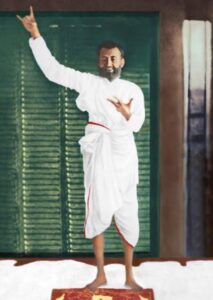
SRI RAMAKRISHNA’s REALISATION OF NIRVIKALPA SAMADHI
What he had realized on the heights of the transcendental plane, he also found here below, everywhere about him, under the mysterious garb of names and forms. And this garb was a perfectly transparent sheath, through which he recognized the glory of the Divine Immanence. Māyā, the mighty weaver of the garb, is none other than Kāli, the Divine Mother. She is the primordial Divine Energy, Śakti, and She can no more be distinguished from the Supreme Brahman than can the power of burning be distinguished from fire. She projects the world and again withdraws it. She spins it as the spider spins its web. She is the Mother of the Universe, identical with the Brahman of Vedānta, and with the Ātman of Yoga. As eternal Lawgiver, She makes and unmakes laws; it is by Her imperious will that karma yields its fruit. She ensnares men with illusion and again releases them from bondage with a look of Her benign eyes. She is the supreme Mistress of the cosmic play, and all objects, animate and inanimate, dance by Her will. Even those who realize the Absolute in nirvikalpa samādhi are under Her jurisdiction as long as they still live on the relative plane.
After nirvikalpa samādhi, Sri Ramakrishna realized māyā in an altogether new role. The binding aspect of Kāli vanished from before his vision. She no longer obscured his understanding. The world became the glorious manifestation of the Divine Mother. Māyā became Brahman. The Transcendental Itself broke through the Immanent.
Sri Ramakrishna discovered that māyā operates in the relative world in two ways, and he termed these “avidyāmāyā” and “vidyāmāyā”. Avidyāmāyā represents the dark forces of creation: sensuous desires, evil passions, greed, lust, cruelty, and so on. It sustains the world system on the lower planes. It is responsible for the round of man’s birth and death. It must be fought and vanquished. But vidyāmāyā is the higher force of creation: the spiritual virtues, the enlightening qualities, kindness, purity, love, devotion. Vidyāmāyā elevates man to the higher planes of consciousness. With the help of vidyāmāyā the devotee rids himself of avidyāmāyā; he then becomes māyātita, free of māyā.
The two aspects of māyā are the two forces of creation, the two powers of Kāli; and She stands beyond them both. She is like the effulgent sun, bringing into existence and shining through and standing behind the clouds of different colours and shapes, conjuring up wonderful forms in the blue autumn heaven.
The Divine Mother asked Sri Ramakrishna not to be lost in the featureless Absolute but to remain in bhāvamukha, on the threshold of relative consciousness, the border line between the Absolute and the Relative. He was to keep himself at the “sixth centre” of Tantra, from which he could see not only the glory of the seventh, but also the divine manifestations of the Kundalini in the lower centres. He gently oscillated back and forth across the dividing line. Ecstatic devotion to the Divine Mother alternated with serene absorption in the Ocean of Absolute Unity.
He thus bridged the gulf between the Personal and the Impersonal, the immanent and the transcendent aspects of Reality. This is a unique experience in the recorded spiritual history of the world.
The Gospel of Sri Ramakrishna p85-87,
~ Foreward by Aldous Huxley, New York, Ramkrishna-Vivekananda Centre
